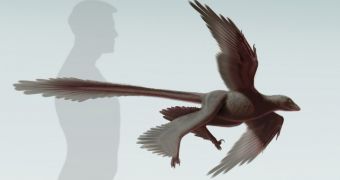This past July 15, researchers announced the discovery of the fossil remains of a dinosaur argued to be the absolute biggest four-winged creature of its kind thus far documented by science.
The fossil remains in question originate from China's Liaoning Province. According to paleontologists who have had the chance to study them, they are about 125 million years old, Science Daily informs.
As explained in a paper in the journal Nature Communications, the fossilized dinosaur bones were left behind by a representative of a species now known to the scientific community as Changyuraptor yangi.
The creature died after reaching adulthood. At the time when it met the Grim Reaper, it weighed about 9 pounds (some 4 kilograms), Dr. Luis Chiappe with the Natural History Museum of Los Angeles County in the US says.
By the looks of it, this long-lost creature had a fairly peculiar anatomy, which made it more similar to birds than to the dinosaurs staring in Steven Spielberg's “Jurassic Park.” In a nutshell, its body was almost entirely covered in feathers.
In fact, researchers explain that, during its heydays, the Changyuraptor yangi found in China sported quite many feathers on its arms and legs. Hence, when seen from afar, the 125-million-year-old creature looked as if it had four wings.
Besides, Changyuraptor yangi had feathers adorning its tail. Of these tail feathers, some measured about 1 foot (approximately 0.3 meters) in length. Together with the wing-like arms and legs, they helped the creature navigate its surroundings.
Based on these odd anatomical particularities, there are some who say that, all things considered, chances are that the 125-million-year-old creature was very much capable to lift its body from the ground and go flying through the air.
“Numerous features that we have long associated with birds in fact evolved in dinosaurs long before the first birds arrived on the scene. This includes things such as hollow bones, nesting behavior, feathers, and possibly flight,” says Dr. Alan Turner of Stony Brook University in the US.
“The new fossil documents that dinosaur flight was not limited to very small animals but to dinosaurs of more substantial size. Clearly far more evidence is needed to understand the nuances of dinosaur flight, but Changyuraptor is a major leap in the right direction,” adds Dr. Luis Chiappe.
Evidence at hand suggests that the Changyuraptor yangi specimen unearthed in China, together with the other representatives of this species, was a predatory dinosaur. Supposing that these creatures were in fact able to fly, it is likely that they relied on this ability to secure their next meal.

 14 DAY TRIAL //
14 DAY TRIAL //